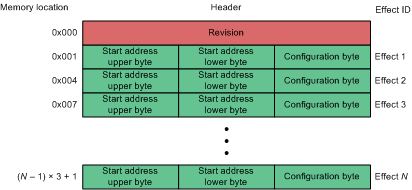SLOS824C December 2012 – March 2018 DRV2604
PRODUCTION DATA.
- 1 Features
- 2 Applications
- 3 Description
- 4 Revision History
- 5 Pin Configuration and Functions
- 6 Specifications
-
7 Detailed Description
- 7.1 Overview
- 7.2 Functional Block Diagram
- 7.3
Feature Description
- 7.3.1 Support for ERM and LRA Actuators
- 7.3.2 Smart-Loop Architecture
- 7.3.3 Open-Loop Operation for LRA
- 7.3.4 Open-Loop Operation for ERM
- 7.3.5 Flexible Front-End Interface
- 7.3.6 Edge Rate Control
- 7.3.7 Constant Vibration Strength
- 7.3.8 Battery Voltage Reporting
- 7.3.9 One-Time Programmable (OTP) Memory for Configuration
- 7.3.10 Low-Power Standby
- 7.3.11 Device Protection
- 7.4 Device Functional Modes
- 7.5
Programming
- 7.5.1 Auto-Resonance Engine Programming for the LRA
- 7.5.2 Automatic-Level Calibration Programming
- 7.5.3 I2C Interface
- 7.5.4 Programming for Open-Loop Operation
- 7.5.5 Programming for Closed-Loop Operation
- 7.5.6 Auto Calibration Procedure
- 7.5.7 Programming On-Chip OTP Memory
- 7.5.8 Waveform Playback Programming
- 7.6
Register Map
- 7.6.1 Status (Address: 0x00)
- 7.6.2 Mode (Address: 0x01)
- 7.6.3 Real-Time Playback Input (Address: 0x02)
- 7.6.4 HI_Z (Address: 0x03)
- 7.6.5 Waveform Sequencer (Address: 0x04 to 0x0B)
- 7.6.6 GO (Address: 0x0C)
- 7.6.7 Overdrive Time Offset (Address: 0x0D)
- 7.6.8 Sustain Time Offset, Positive (Address: 0x0E)
- 7.6.9 Sustain Time Offset, Negative (Address: 0x0F)
- 7.6.10 Brake Time Offset (Address: 0x10)
- 7.6.11 Rated Voltage (Address: 0x16)
- 7.6.12 Overdrive Clamp Voltage (Address: 0x17)
- 7.6.13 Auto-Calibration Compensation Result (Address: 0x18)
- 7.6.14 Auto-Calibration Back-EMF Result (Address: 0x19)
- 7.6.15 Feedback Control (Address: 0x1A)
- 7.6.16 Control1 (Address: 0x1B)
- 7.6.17 Control2 (Address: 0x1C)
- 7.6.18 Control3 (Address: 0x1D)
- 7.6.19 Control4 (Address: 0x1E)
- 7.6.20 V(BAT) Voltage Monitor (Address: 0x21)
- 7.6.21 LRA Resonance Period (Address: 0x22)
- 7.6.22 RAM-Address Upper Byte (Address: 0xFD)
- 7.6.23 RAM-Address Lower Byte (Address: 0xFE)
- 7.6.24 RAM Data Byte (Address: 0xFF)
- 8 Application and Implementation
- 9 Power Supply Recommendations
- 10Layout
- 11Device and Documentation Support
- 12Mechanical, Packaging, and Orderable Information
Package Options
Mechanical Data (Package|Pins)
- YZF|9
Thermal pad, mechanical data (Package|Pins)
Orderable Information
7.5.8.2.4.1 Header Format
The header block consist of N-boundary definition blocks of 3 bytes each. N is the number of effects stored in the RAM. Each of the boundary definition blocks contain the start address (2 bytes) and a configuration byte.
The start address contains the location in the memory where the waveform data associated with this effect begins. The position of the effect pointer in the header becomes the effect ID. The first effect boundary definition points to the ID for effect 1, the second definition points to the ID for effect 2, and so on. This resulting effect ID is the effect ID that is used in the waveform sequencer.
 Figure 27. Header Structure
Figure 27. Header Structure The configuration byte contains the following two parameters:
- The effect size contains the amount of bytes that define the waveform data. An effect size of 0 is an error state. Any odd-number effect size is an error state because the waveform data is defined as time-value (2 bytes). Therefore, the effect size must be an even number between 2 and 30.
- The WAVEFORM_REPEATS[2:0] bit is used to select the number of times the complete waveform is be played when it is called by the waveform sequencer. A value of 0 is no repeat and the waveform is played once. A value of 1 means 1 repeat and the waveform is played twice. A value of 7 means infinite repeat until the GO bit is cleared.
During waveform design, ensure that the appropriate amount of drive time is at zero amplitude on the end of the waveform so that the waveform stored in the RAM is repeated smoothly.
 Figure 28. Header Configuration Byte Structure
Figure 28. Header Configuration Byte Structure